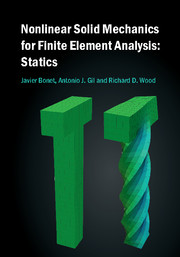Book contents
- Frontmatter
- Dedication
- Epigraph
- Contents
- Preface
- 1 INTRODUCTION
- 2 MATHEMATICAL PRELIMINARIES
- 3 ANALYSIS OF THREE-DIMENSIONAL TRUSS STRUCTURES
- 4 KINEMATICS
- 5 STRESS AND EQUILIBRIUM
- 6 HYPERELASTICITY
- 7 LARGE ELASTO-PLASTIC DEFORMATIONS
- 8 LINEARIZED EQUILIBRIUM EQUATIONS
- 9 DISCRETIZATION AND SOLUTION
- 10 COMPUTER IMPLEMENTATION
- Bibliography
- Index
4 - KINEMATICS
Published online by Cambridge University Press: 05 June 2016
- Frontmatter
- Dedication
- Epigraph
- Contents
- Preface
- 1 INTRODUCTION
- 2 MATHEMATICAL PRELIMINARIES
- 3 ANALYSIS OF THREE-DIMENSIONAL TRUSS STRUCTURES
- 4 KINEMATICS
- 5 STRESS AND EQUILIBRIUM
- 6 HYPERELASTICITY
- 7 LARGE ELASTO-PLASTIC DEFORMATIONS
- 8 LINEARIZED EQUILIBRIUM EQUATIONS
- 9 DISCRETIZATION AND SOLUTION
- 10 COMPUTER IMPLEMENTATION
- Bibliography
- Index
Summary
INTRODUCTION
It is almost a tautology to say that a proper description of motion is fundamental to finite deformation analysis, but such an emphasis is necessary because infinitesimal deformation analysis implies a host of assumptions that we take for granted and seldom articulate. For example, we have seen in Chapter 1, in the simple truss example, that care needs to be exercised when large deformations are anticipated and that a linear definition of strain is totally inadequate in the context of a finite rotation. A study of finite deformation will require that cherished assumptions be abandoned and a fresh start made with an open (but not empty!) mind.
Kinematics is the study of motion and deformation without reference to the cause. We shall see immediately that consideration of finite deformation enables alternative coordinate systems to be employed, namely, material and spatial descriptions associated with the names of Lagrange and Euler respectively.
Although we are not directly concerned with inertial effects, nevertheless time derivatives of various kinematic quantities enrich our understanding and also provide the basis for the formulation of the virtual work expression of equilibrium, which uses the notion of virtual velocity and associated kinematic quantities.
Wherever appropriate, nonlinear kinematic quantities are linearized in preparation for inclusion in the linearized equilibrium equations that form the basis of the Newton–Raphson solution to the finite element equilibrium equations.
THE MOTION
Figure 4.1 shows the general motion of a deformable body. The body is imagined as being an assemblage of material particles that are labeled by the coordinates X, with respect to Cartesian basis EI, at their initial positions at time t = 0. Generally, the current positions of these particles are located, at time = t, by the coordinates x with respect to an alternative Cartesian basis ei. In the remainder of this chapter the bases EI and ei will be taken to be coincident. However, the notational distinction between EI and ei will be retained in order to identify the association of quantities with initial or current configurations. The motion can be mathematically described by a mapping ϕ between initial and current particle positions as
For a fixed value of t the above equations represent a mapping between the undeformed and deformed bodies. Additionally, for a fixed particle X, Equation (4.1) describes the motion or trajectory of this particle as a function of time.
- Type
- Chapter
- Information
- Publisher: Cambridge University PressPrint publication year: 2016



